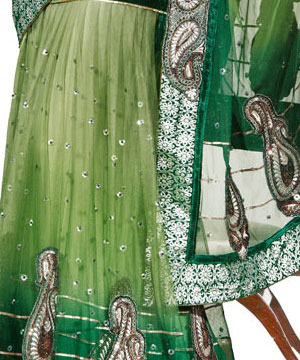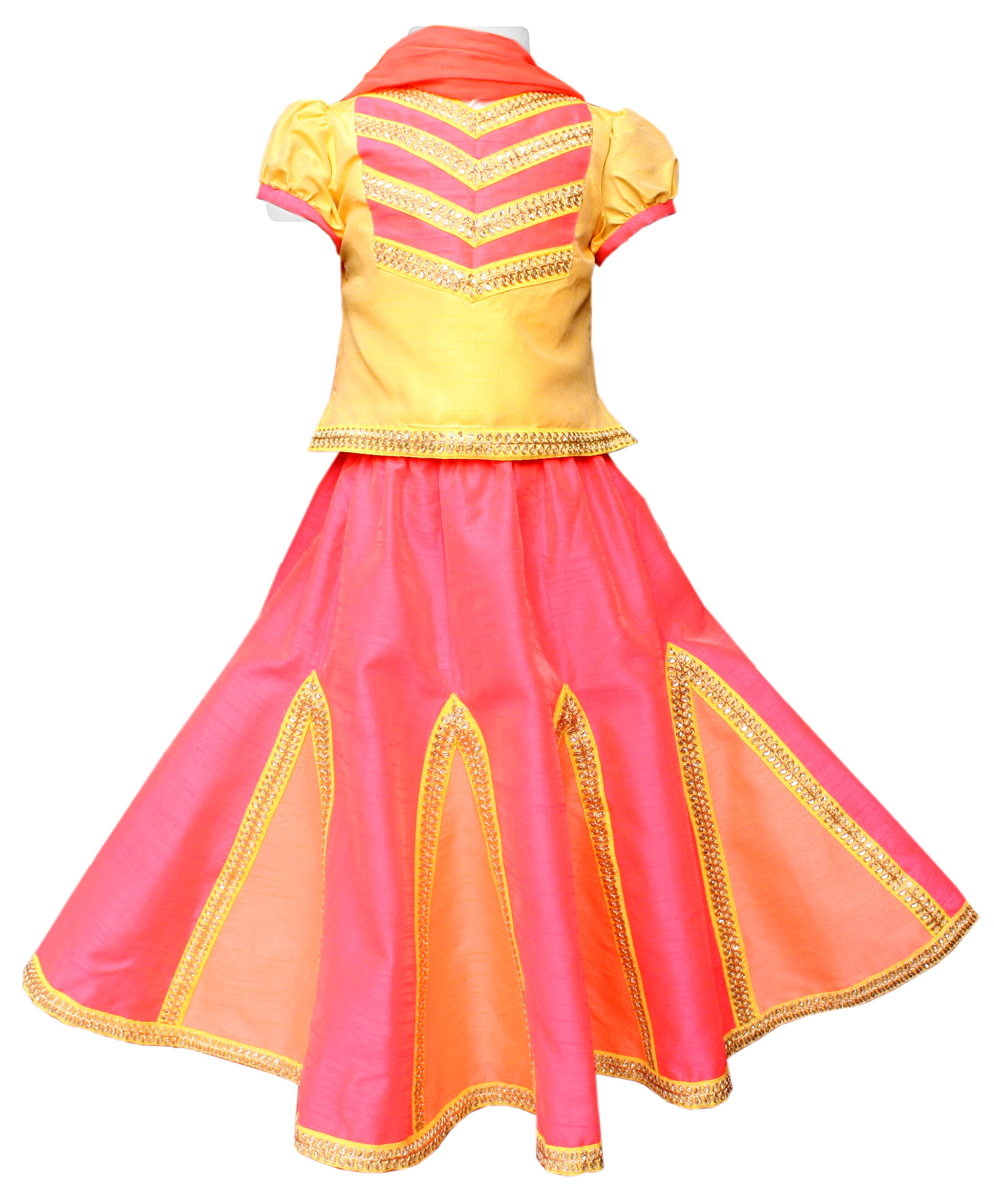Soource:- Google.com.pk
A lehenga is a skirt worn with a choli, also called a gypsy skirt or gopi skirt. While women of the Gujarat and Rajasthan provinces of India usually represent the outfit for foreigners, the lehenga is native to several other parts of India too. Depending on which part of India one is referring to, the lehenga is worn in different styles, made of different fabrics and includes unique patterns. The lehenga of Rajasthan and Gujarat is known for its bandhni work which is a technique in tie-dye mastered by Hindu women of the region. In the Southern states of India, the lehenga skirt is not as voluminous and is worn without a chunni but with a kurti that covers the midriff. The lehenga worn in the Northern states of Uttar Pradesh and Uttarkhand has a voluminous skirt and kurti that covers midriff with a long chunni.
The practice of wearing petticoats as undergarments was well established by 1585. Petticoats were worn throughout history by women who wanted to have the currently fashionable shape created by their clothing. The petticoat(s), if sufficiently full or stiff, would hold the overskirt out in a pleasingly domed shape and give the impression of a smaller waist than the wearer actually had. It would also complement the desired large bust. Elaborately decorated petticoats were worn under open-fronted gowns and looped overskirts from the mid-sixteenth century. Eighteenth century petticoats of wool or silk were often quilted for additional warmth and were worn with matching short gowns or jackets, which could be fashioned like a man's jacket with military details and trimmings. These ankle-length petticoats remained a rural fashion, especially in the UK, into the nineteenth century and are a part of Welsh national dress.
Elaborate, lacy petticoats were worn with elegant silk dresses in the eighteenth century in much of Europe and America, sometimes supported by whalebone frames. The Laurel and Hardy film adaptation of Auber's comic opera Fra Diavolo offers a glimpse of the intricate petticoats, corsets, and other underwear worn in the eighteenth century, especially in a scene where actress Thelma Todd prepares for bed, assisted by a maid. Colored pictures, called "fashion plates", were used to advertise the popular dresses and lingerie of the eighteenth century, a practice that continued through the nineteenth century until the introduction of photography around 1840.
A choli (lengha in Urdu or ravika in Telugu) is a midriff-baring blouse worn in India, Pakistan, Sri Lanka, Bangladesh, and other countries where the sari is worn. The choli is cut to fit tightly to the body and has short sleeves and a low neck. The choli is usually cropped, allowing exposure of the navel; the cropped design is particularly well-suited for wear in the sultry South Asian summers. Cut-out backs and front-opening buttons are some of the features of contemporary designs. Saris are often woven with an extra length of material meant to be cut off and fashioned into a matching choli. The choli may be sewn so that the elaborately woven borders of the sari material form the bottom edges of the choli sleeves. However, cholis need not match the sari. Some Western women have started wearing the choli as part of their belly dance costume. They typically wear backless cholis (held together with strings) so that the audience can see a dancer's bare back as she sways. Should be worn with shalwar or lehenga
A short tight Ottoman vest, cut like the entari, but more fitted in the body, with the hem about mid-thigh length to above the knee. There are several sleeve possibilities. It is worn over the gomlek and under the entari. It is clear in paintings and surviving garments that the front is cut straight down, but is pulling apart across the fullness of the bust. In this case, the garment has a small circular neckline right at the base of the neck. Generally the chirka had buttons from the neck down, but is left open across the bust. It also appears to have a small standing collar, the Chirka may have a fully buttoned front or it may have a rounded V-neck. If cut "correctly" it can provide bust support with no modern supplements. I have no guarantee that this was done "in period", but it's possible. The same garment names are used in Turkish for centuries, yet the garment shapes change radically. This word is used for a couple different garments in the 19th through 21st centuries, quite different from that of the 16th c. Several scholarly sources call it hirka or chirka (Encyclopedia of Islam, 8th ed., for example) Common materials include linen, silks and wool.
Net Lehenga Design lehnga design 2014 Latest for engagement images for kids for marriage for bride
Net Lehenga Design lehnga design 2014 Latest for engagement images for kids for marriage for bride
Net Lehenga Design lehnga design 2014 Latest for engagement images for kids for marriage for bride
Net Lehenga Design lehnga design 2014 Latest for engagement images for kids for marriage for bride
Net Lehenga Design lehnga design 2014 Latest for engagement images for kids for marriage for bride
Net Lehenga Design lehnga design 2014 Latest for engagement images for kids for marriage for bride
Net Lehenga Design lehnga design 2014 Latest for engagement images for kids for marriage for bride
Net Lehenga Design lehnga design 2014 Latest for engagement images for kids for marriage for bride
Net Lehenga Design lehnga design 2014 Latest for engagement images for kids for marriage for bride
Net Lehenga Design lehnga design 2014 Latest for engagement images for kids for marriage for bride
.jpg)









No comments:
Post a Comment